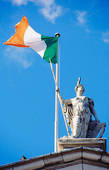
Origin of the Irish Tricolor

By Mary McGuire
MARCH 1848 - Waterford City was where the Irish tricolor was first unveiled. Shortly after that, it became the national flag of Ireland. Thomas Francis Meagher had it hanging for some time at number 33 The Mall. The Lord Mayor at the time, Sylvester Phelan, was not quite sure what he should do about this. So he wrote to the under-secretary for Ireland T.N. Reddington, looking for advice. It is thought that the Mayor never received a reply and the flag flew on.
Prior to the flag flying from the building in Waterford, Irish people had begun wearing green, white and orange rosettes to show their wish for a united people. The colors were seen at rallies, celebrations, sports etc. The French Revolution was happening at the same time, and the young and inventive Thomas Meagher became inspired by their use of a tricolor.
In April 1848 both he and William Smith O’Brien travelled to France to seek support for their cause. The French were reluctant to provide direct support, but a group of French women sympathetic to the Irish cause presented them with a very special gift. They returned with a silken tricolor, and on April 15, 1848 they presented it to the other members of the Irish Confederation.
On the meaning of the flag, Thomas Meagher said “I trust that the old country will not refuse this symbol of a new life from one of her youngest children. I need not explain its meaning. The quick and passionate intellect of the generation now springing into arms will catch it at a glance. The white in the centre signifies a lasting truce between the “orange” and the “green” and I trust that beneath its folds, the hands of the Irish Protestant and the Irish Catholic may be clasped in generous and heroic brotherhood”.
It was not until the Easter Rising of 1916 that the tricolor made another significant appearance, and in 1937 this version was formally recognized as the flag of Ireland.